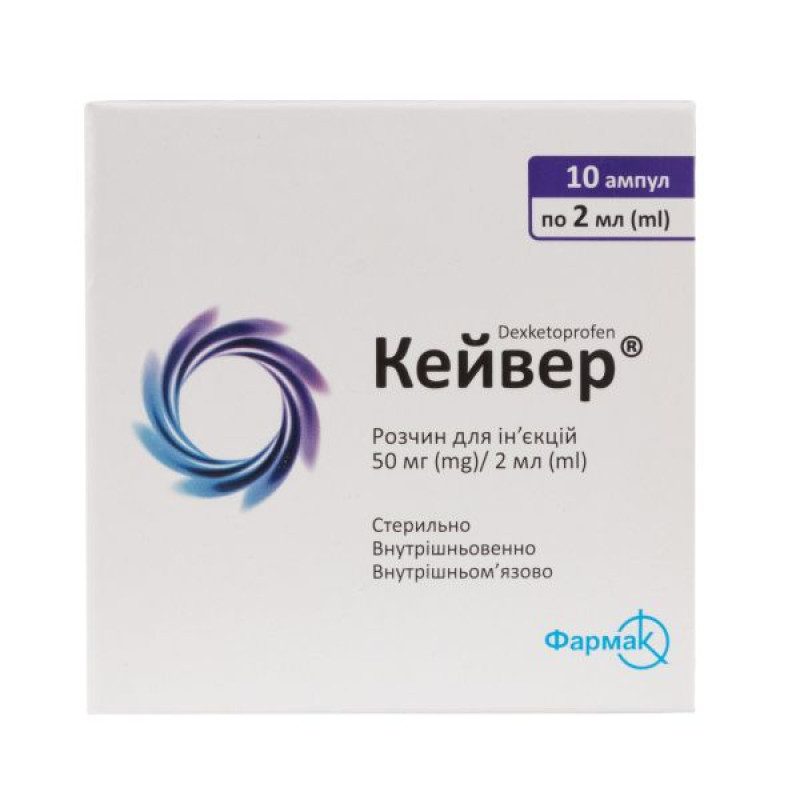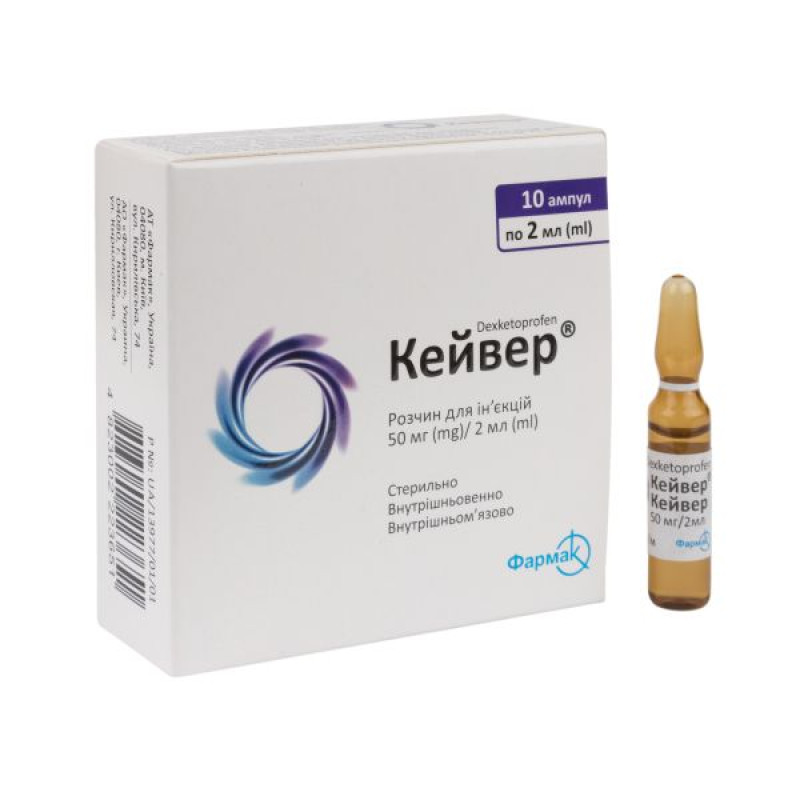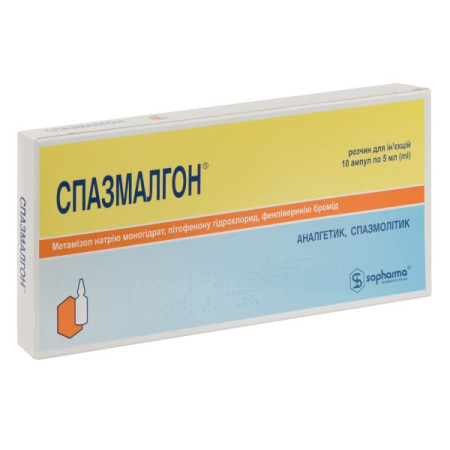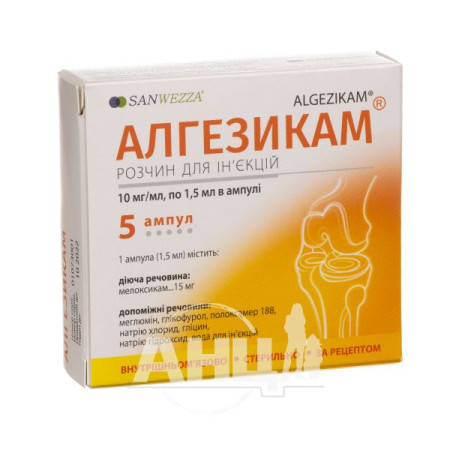Keiver solution for injection 50 mg/2 ml ampoule 2 ml No. 10
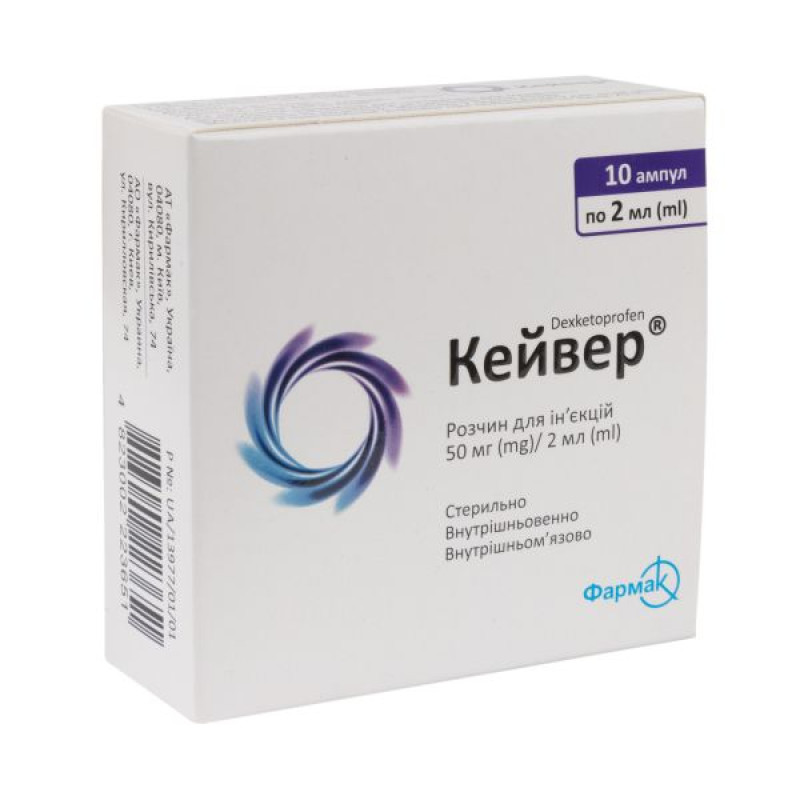
Instructions for use: Keiver solution for injection 50 mg/2 ml, ampoule 2 ml, No. 10
Composition
active ingredient: 1 ml of solution contains: dexketoprofen trometamol calculated on 100% dry matter 36.9 mg, which is equivalent to dexketoprofen 25 mg;
Excipients: ethanol 96%, sodium chloride, sodium hydroxide, water for injections.
Dosage form
Solution for injection.
Main physicochemical properties: clear colorless liquid.
Pharmacotherapeutic group
Nonsteroidal anti-inflammatory and antirheumatic drugs. Propionic acid derivatives. Dexketoprofen. ATX code M01A E17.
Pharmacological properties
Pharmacodynamics
Dexketoprofen trometamol is a propionic acid salt that has analgesic, anti-inflammatory and antipyretic effects and belongs to the class of non-steroidal anti-inflammatory drugs (NSAIDs). Its mechanism of action is based on a decrease in prostaglandin synthesis by inhibiting cyclooxygenase. In particular, the conversion of arachidonic acid into cyclic endoperoxides PGG2 and PGH2 is inhibited, from which prostaglandins PGE1, PGE2, PGF2a, PGD2 are formed, as well as prostacyclin PGI2 and thromboxanes TxA2 and TxB2. In addition, inhibition of prostaglandin synthesis may affect other inflammatory mediators, such as kinins, which may also indirectly affect the main effect of the drug. Dexketoprofen trometamol has been shown to inhibit the activity of cyclooxygenase-1 and cyclooxygenase-2. Clinical studies in various types of pain have demonstrated that dexketoprofen trometamol has a pronounced analgesic effect. The analgesic effect of dexketoprofen trometamol when administered intramuscularly and intravenously to patients with moderate to severe pain has been studied in various types of pain during surgical interventions (orthopedic and gynecological operations, abdominal operations), as well as in musculoskeletal pain (acute low back pain) and renal colic. During the studies, the analgesic effect of the drug began quickly and reached a maximum within the first 45 minutes. The duration of the analgesic effect after the use of 50 mg of dexketoprofen trometamol is usually 8 hours. Clinical studies have demonstrated that the use of the drug Keiver® allows for a significant reduction in the dose of opiates when used simultaneously for the purpose of relieving postoperative pain. When patients who were given morphine for postoperative pain relief using a patient-controlled analgesia device were also given dexketoprofen trometamol, they required significantly less morphine (by 30-45%) than patients who received placebo.
Pharmacokinetics
After intramuscular administration of dexketoprofen trometamol, the maximum concentration of the drug in the blood plasma (Cmax) is reached after approximately 20 minutes (10–45 minutes). It has been proven that with a single intramuscular or intravenous administration of 25–50 mg of the drug, the area under the "concentration-time" curve (AUC) is proportional to the dose. Pharmacokinetic studies of multiple use of the drug have shown that the AUC and mean Cmax after the last intramuscular and intravenous administration do not differ from those after a single administration, which indicates the absence of drug accumulation. Similar to other drugs with a high degree of binding to plasma proteins (99%), the volume of distribution of dexketoprofen is on average 0.25 l/kg. The half-life is approximately 0.35 hours, and the half-life is 1–2.7 hours. Dexketoprofen is mainly metabolized by conjugation with glucuronic acid and subsequent renal excretion. After administration of dexketoprofen trometamol, only the S–(+) optical isomer is detected in the urine, indicating that there is no transformation of the drug into the R–(-) optical isomer. After administration of single and multiple doses, the degree of exposure of the drug to healthy elderly volunteers (aged 65 years and older) participating in the study was significantly higher (up to 55%) than to young volunteers, but no statistically significant difference in Cmax and time to its achievement was observed. The mean half-life increased (up to 48%), and the determined total clearance decreased.
Indication
Symptomatic treatment of acute pain of moderate to severe intensity in cases where oral administration of the drug is inappropriate, for example, in postoperative pain, renal colic and lumbago (back pain).
Contraindication
- Hypersensitivity to dexketoprofen, any other non-steroidal anti-inflammatory drug (NSAID) or to the excipients of the drug;
- if substances with a similar effect, such as acetylsalicylic acid or other NSAIDs, provoke the development of attacks of bronchial asthma, bronchospasm, acute rhinitis or cause the development of nasal polyps, the appearance of urticaria or angioedema;
- if photoallergic or phototoxic reactions occurred during treatment with ketoprofen or fibrates;
- active peptic ulcer/gastrointestinal bleeding, or history of gastrointestinal bleeding, ulcers or perforations;
- chronic dyspepsia;
- history of gastrointestinal bleeding or perforation related to previous NSAID therapy;
- Crohn's disease or nonspecific ulcerative colitis;
- severe heart failure;
- moderate or severe renal impairment (creatinine clearance < 50 ml/min);
- severe liver dysfunction (10–15 points on the Child–Pugh scale);
- hemorrhagic diathesis and other blood clotting disorders;
- with severe dehydration (due to vomiting, diarrhea or insufficient fluid intake);
- III trimester of pregnancy and breastfeeding period;
- use for the purpose of neuraxial (intrathecal or epidural) administration (due to the ethanol content).
Interaction with other medicinal products and other types of interactions
Concomitant use of such agents with NSAIDs is not recommended.
- Other NSAIDs, including salicylates in high doses (≥ 3 g/day). The simultaneous use of several NSAIDs increases the risk of gastrointestinal ulcers and bleeding due to their mutually reinforcing effects.
- Anticoagulants: NSAIDs enhance the effect of anticoagulants, such as warfarin, due to the high degree of binding of dexketoprofen to blood plasma proteins, as well as inhibition of platelet function and damage to the gastric and duodenal mucosa. If concomitant use is necessary, it should be carried out under close medical supervision, monitoring of relevant laboratory parameters.
- Heparin: increased risk of bleeding (due to inhibition of platelet function and damage to the gastric and duodenal mucosa). If concomitant use is necessary, it should be carried out under close medical supervision, monitoring of relevant laboratory parameters.
- Corticosteroids: increased risk of developing ulcers in the digestive tract and gastrointestinal bleeding.
- Lithium (reported for several NSAIDs): NSAIDs increase the level of lithium in the blood, which can lead to intoxication (reduced renal excretion of lithium), therefore, at the beginning of dexketoprofen use, when adjusting the dose or discontinuing the drug, it is necessary to monitor the level of lithium in the blood.
- Methotrexate in high doses (at least 15 mg per week): due to the decrease in renal clearance of methotrexate against the background of the use of NSAIDs, its negative effect on the blood system is generally increased.
- Hydantoin derivatives and sulfonamides: possible increase in the toxicity of these substances.
Concomitant use of such agents with NSAIDs requires caution.
- Diuretics, angiotensin-converting enzyme (ACE) inhibitors, antibacterial aminoglycosides and angiotensin II receptor antagonists. Dexketoprofen reduces the effectiveness of diuretics and other antihypertensive agents. In some patients with impaired renal function (e.g., in cases of dehydration or in the elderly), the use of cyclooxygenase inhibitors concomitantly with ACE inhibitors, angiotensin II receptor antagonists or antibacterial aminoglycosides may lead to a deterioration in renal function, which is usually reversible. When using dexketoprofen with any diuretic, it is necessary to ensure that the patient is not dehydrated, and renal function should be monitored at the beginning of treatment.
- Methotrexate in low doses (less than 15 mg per week): due to the decrease in renal clearance of methotrexate during the use of NSAIDs, its negative effect on the blood system in general is increased. In the first weeks of simultaneous use, it is necessary to conduct a blood test every week. Even with a slight impairment of renal function, as well as in elderly patients, treatment should be carried out under strict medical supervision.
- Pentoxifylline: there is a risk of bleeding. It is necessary to increase monitoring and check the bleeding time more frequently.
- Zidovudine: there is a risk of increased toxicity to red blood cells due to effects on reticulocytes, leading to severe anemia after the first week of NSAID use. A blood test and reticulocyte count should be performed within 1–2 weeks of starting NSAID use.
- Sulfonylureas: NSAIDs can enhance the hypoglycemic effect of these agents by displacing sulfonylureas from their plasma protein binding.
Possible interactions should be considered when using such agents.
- Beta-blockers: NSAIDs can weaken their antihypertensive effect by inhibiting prostaglandin synthesis.
- Cyclosporine and tacrolimus: possible increased nephrotoxicity due to the effect of NSAIDs on renal prostaglandins; renal function should be monitored during combination therapy.
- Thrombolytic agents: increased risk of bleeding.
- Antiplatelet agents and selective serotonin reuptake inhibitors: increased risk of gastrointestinal bleeding.
- Probenecid: an increase in dexketoprofen plasma concentrations is possible, which is likely due to inhibition of renal tubular secretion and conjugation of the drug with glucuronic acid and requires correction of the dexketoprofen dose.
- Mifepristone: there is a theoretical risk that the efficacy of mifepristone may be altered by prostaglandin synthetase inhibitors. Limited data suggest that co-administration of NSAIDs on the same day as a prostaglandin does not adversely affect the efficacy of mifepristone or prostaglandin in cervical ripening or contractility, nor does it reduce the clinical efficacy of medical abortion;
- Quinolone: animal studies have shown that the use of quinolone derivatives in high doses in combination with NSAIDs increases the risk of seizures.
- Tenofovir: when used concomitantly with NSAIDs, the concentration of urea nitrogen and creatinine in the blood plasma may increase, therefore, to assess the possible effect of the concomitant use of these drugs, it is necessary to monitor renal function;
- Deferasirox: the risk of gastrointestinal toxicity may be increased when used concomitantly with NSAIDs. Careful patient monitoring is required when this medicinal product is used concomitantly with deferasirox;
- Pemetrexed: Pemetrexed excretion may be reduced when used concomitantly with NSAIDs, therefore special caution should be exercised when using NSAIDs at high doses. Patients with mild to moderate renal impairment (creatinine clearance 45 to 79 ml/min) should avoid NSAIDs for two days before and two days after taking pemetrexed.
Application features
The drug should be used with caution in patients with a history of allergic conditions. Avoid using Kevere® in combination with other NSAIDs, including selective cyclooxygenase-2 inhibitors. Adverse reactions can be reduced by using the lowest effective dose for the shortest time necessary to improve the condition.
Gastrointestinal safety
Gastrointestinal bleeding, ulceration or perforation, in some cases fatal, have been reported with all NSAIDs at various stages of treatment, regardless of the presence of warning symptoms or a history of serious gastrointestinal disease. If gastrointestinal bleeding occurs, the drug should be discontinued. The risk of gastrointestinal bleeding, ulceration or perforation increases with increasing NSAID dose in patients with a history of ulcer, especially if complicated by bleeding or perforation, and in the elderly. Elderly patients have an increased incidence of adverse reactions to NSAIDs, especially gastrointestinal bleeding and perforation, sometimes fatal. Treatment of such patients should be started at the lowest possible dose. NSAIDs should be prescribed with caution to patients with a history of gastrointestinal disease, as there is a risk of exacerbation. The use of NSAIDs may lead to relapses of ulcerative colitis and Crohn's disease in patients who are in remission. Before starting the use of dexketoprofen trometamol in patients with a history of esophagitis, gastritis and/or peptic ulcer disease, it should be ensured that these diseases are in remission. In patients with existing symptoms of gastrointestinal pathology and with a history of gastrointestinal diseases, the condition of the gastrointestinal tract should be monitored for possible disorders during the use of the drug, especially gastrointestinal bleeding.
For such patients and patients taking low-dose acetylsalicylic acid or other agents that increase the risk of gastrointestinal adverse reactions, combination therapy with protective agents, such as misoprostol or proton pump inhibitors, should be considered.
Patients, especially the elderly, who have a history of adverse reactions from the digestive tract, should inform their doctor about all unusual symptoms related to the digestive system, in particular gastrointestinal bleeding, especially in the initial stages of treatment.
Caution should be exercised when prescribing the drug to patients who are concomitantly taking agents that may increase the risk of ulceration or bleeding, such as oral corticosteroids, anticoagulants (e.g. warfarin), selective serotonin reuptake inhibitors or antiplatelet agents such as acetylsalicylic acid.
The drug should be prescribed with caution to patients with impaired renal function, since the use of NSAIDs may lead to deterioration of renal function, fluid retention in the body and the appearance of peripheral edema. Due to the increased risk of nephrotoxicity, the drug should be used with caution in treatment with diuretics, as well as in patients who may develop hypovolemia. During treatment, the body should receive a sufficient amount of fluid to avoid dehydration, which can lead to increased toxic effects on the kidneys. Like other NSAIDs, the drug may increase the concentration of urea nitrogen and creatinine in the blood plasma. Like other prostaglandin synthesis inhibitors, its use may be accompanied by adverse reactions from the kidneys, leading to glomerulonephritis, interstitial nephritis, papillary necrosis, nephrotic syndrome and acute renal failure. Most impaired renal function occurs in elderly patients.
Liver safety
The drug should be prescribed with caution to patients with impaired liver function. As with other NSAIDs, the drug may cause a temporary and slight increase in some liver function tests, as well as a significant increase in AST and ALT. If these values increase, treatment should be discontinued.
Most liver dysfunction occurs in elderly patients.
Cardiovascular and cerebrovascular safety
Patients with arterial hypertension and/or mild to moderate congestive heart failure should be closely monitored by a physician due to possible fluid retention and peripheral edema.
According to available clinical and epidemiological data, the use of some NSAIDs, especially at high doses and over long periods, may be associated with a slightly increased risk of arterial thrombotic events such as myocardial infarction or stroke. There are insufficient data to exclude dexketoprofen trometamol.
Dexketoprofen trometamol should only be used after careful assessment of the patient's condition in patients with uncontrolled hypertension, congestive heart failure, established ischemic heart disease, peripheral arterial disease and/or cerebrovascular disease. The same should be done before initiating long-term treatment in patients with risk factors for cardiovascular disease (e.g. hypertension, hyperlipidemia, diabetes mellitus, smoking).
Non-selective NSAIDs can reduce platelet aggregation and increase bleeding time by inhibiting prostaglandin synthesis. The simultaneous use of dexketoprofen trometamol and low molecular weight heparin in prophylactic doses in the postoperative period was studied in clinical studies, no effect on coagulation parameters was found. However, patients who use dexketoprofen trometamol simultaneously with drugs that affect hemostasis, such as warfarin, other coumarins or heparins, should be under close medical supervision.
Particular caution should be exercised when treating patients with a history of heart disease, in particular with previous episodes of heart failure, since the risk of heart failure increases with the use of the drug. Cardiovascular dysfunction is most common in elderly patients.
Skin reactions
There have been very rare reports of serious skin reactions (some fatal) with NSAIDs, including exfoliative dermatitis, Stevens-Johnson syndrome and toxic epidermal necrolysis. Patients appear to be at greatest risk at the start of treatment, with most patients experiencing these reactions within the first month of treatment. If skin rash, signs of mucosal involvement or other signs of hypersensitivity occur, Kevere® should be discontinued.
Masking the symptoms of underlying infections
Kevere® may mask the symptoms of infections, which may prevent diagnosis and timely treatment and, thereby, worsen the consequences of the infection. Such cases have been observed with bacterial pneumonia and bacterial complications of chickenpox. When Kevere® is administered for the relief of pain associated with an infectious process, monitoring of the infectious process is recommended. In outpatient settings, the patient should consult a doctor if symptoms persist or worsen.
Other information
Particular caution should be exercised when prescribing the drug to patients:
- with hereditary disorders of porphyrin metabolism (for example, with acute intermittent porphyria);
- with dehydration;
- immediately after major surgical interventions.
If the doctor considers that long-term use of dexketoprofen is necessary, liver and kidney function should be monitored regularly.
Patients with asthma in combination with chronic rhinitis, chronic sinusitis and/or nasal polyps are at higher risk of allergy to acetylsalicylic acid and/or NSAIDs than other patients. The administration of this drug may cause asthma attacks or bronchospasm, especially in patients with allergy to acetylsalicylic acid or NSAIDs.
Severe infectious complications of the skin and soft tissues may develop in the setting of chickenpox. To date, there is no data to rule out the role of NSAIDs in aggravating this infectious process. Therefore, the use of Keiver® is not recommended in the setting of chickenpox.
Keiver® should be administered with caution to patients with hematopoietic disorders, systemic lupus erythematosus, and mixed connective tissue diseases.
In isolated cases, there have been reports of activation of infectious processes localized in soft tissues during the use of PNZZ. Therefore, if symptoms of a bacterial infection appear or worsen during the use of the drug, patients are advised to consult a doctor immediately.
One ampoule of the drug Keiver® contains 200 mg of ethanol, which is equal to 5 ml of beer or 2.08 ml of wine per dose. The drug may have a negative effect on people suffering from alcoholism. The ethanol content should be taken into account when using the drug in the 1st and 2nd trimesters of pregnancy, in children and patients at risk, for example, with liver disease, as well as patients with epilepsy. The drug contains less than 1 mmol sodium (23 mg) per dose, i.e. practically free of sodium.
Use during pregnancy or breastfeeding
The use of the drug Keiver® is contraindicated in the third trimester of pregnancy and during breastfeeding.
Pregnancy
Inhibition of prostaglandin synthesis may adversely affect pregnancy and/or fetal development. Epidemiological studies have shown that the use of drugs that inhibit prostaglandin synthesis in early pregnancy increases the risk of miscarriage, fetal heart defects and anterior abdominal wall non-union. Thus, the absolute risk of developing cardiovascular anomalies increased from < 1% to approximately 1.5%. It is believed that the risk of such phenomena increases with increasing dose and duration of therapy. The use of prostaglandin synthesis inhibitors in animals caused an increase in pre- and post-implantation losses and increased embryo-fetal mortality. In addition, in animals treated with prostaglandin synthesis inhibitors during organogenesis, the incidence of fetal malformations, including cardiovascular anomalies, increased. However, studies of dexketoprofen trometamol in animals did not reveal reproductive toxicity. From the 20th week of pregnancy, the use of Keiver® may cause oligohydramnios due to fetal renal dysfunction. This may occur shortly after the start of treatment and is usually reversible after discontinuation of treatment. Dexketoprofen trometamol should be prescribed in the first and second trimesters of pregnancy only if clearly needed. When dexketoprofen trometamol is prescribed to women planning a pregnancy or in the first and second trimesters of pregnancy, the lowest effective dose should be used for the shortest possible duration of treatment. Antenatal monitoring for oligohydramnios should be considered after exposure to Keiver® for several days, starting from the 20th week of pregnancy. Keiver® should be discontinued if oligohydramnios is detected.
During the third trimester of pregnancy, all prostaglandin synthesis inhibitors cause the following:
Risks to the fetus:
- cardiopulmonary toxic syndrome (with obstruction of the ductus arteriosus and pulmonary hypertension);
- impaired renal function, which may progress to renal failure with the development of oligohydramnios (see above);
Risks for mother and baby at the end of pregnancy:
- prolongation of bleeding time (effect of inhibiting platelet aggregation), which is possible even when using low doses;
- delayed uterine contractions with corresponding delayed labor and prolonged labor.
Breast-feeding
There is no data on the penetration of dexketoprofen into breast milk. The drug Keiver® is contraindicated during breastfeeding.
Fertility
As with all NSAIDs, dexketoprofen trometamol may impair female fertility and is therefore not recommended in women attempting to conceive. Withdrawal of the drug should be considered in women who have difficulty conceiving or are undergoing investigation of infertility.
Ability to influence reaction speed when driving vehicles or other mechanisms
While using the drug Keiver®, dizziness, visual disturbances or drowsiness may occur, therefore a mild or moderate influence of the drug on the ability to drive or operate other mechanisms cannot be ruled out. Patients should take this into account and objectively assess their ability to perform such work.
Method of administration and doses
Adults. The recommended dose is 50 mg every 8–12 hours. If necessary, a second dose is administered after 6 hours. The maximum daily dose should not exceed 150 mg. The drug is intended for short-term use, therefore it should be used only during the period of acute pain (no more than 2 days). Patients should be transferred to oral analgesics, if possible. Adverse reactions can be reduced by using the lowest effective dose for the shortest possible time necessary to improve the condition. For moderate to severe postoperative pain, the drug can be used according to indications in the same recommended doses in combination with opioid analgesics.
Elderly patients: Dose adjustment is usually not required. However, due to physiologically decreased renal function, a lower dose is recommended, namely: the maximum daily dose is 50 mg in mild renal impairment.
Liver disease. For patients with mild to moderate liver disease (Child-Pugh score 5-9), the maximum daily dose should be reduced to 50 mg and liver function should be closely monitored. The drug is contraindicated in severe liver disease (Child-Pugh score 10-15).
Renal dysfunction. For patients with mild renal impairment (creatinine clearance 50-80 ml/min), the maximum daily dose should be reduced to 50 mg. In patients with moderate or severe renal impairment (creatinine clearance < 50 ml/min), the drug is contraindicated.
Children: The drug should not be used due to the lack of data on its efficacy and safety.
Intramuscular administration. The solution for injection should be injected slowly deep into the muscle.
Intravenous infusion. For intravenous infusion, the contents of the 2 ml ampoule should be diluted in 30–100 ml of 0.9% sodium chloride solution, glucose solution or lactated Ringer's solution. The infusion solution should be prepared under aseptic conditions, avoiding exposure to natural daylight. The prepared solution should be clear. The infusion should be carried out within 10–30 minutes. Avoid exposure to natural daylight on the prepared solution.
Keiver®, diluted in 100 ml of 0.9% sodium chloride solution or glucose solution, can be mixed with dopamine, heparin, hydroxyzine, lidocaine, morphine, pethidine and theophylline.
Keiver® should not be mixed in an infusion solution with promethazine and pentazocine.
Intravenous injection (bolus administration). If necessary, the contents of 1 ampoule (2 ml of solution for injection) are administered intravenously over at least 15 seconds.
The drug can be mixed in small volumes (e.g. in a syringe) with injectable solutions of heparin, lidocaine, morphine and theophylline.
Keiver® cannot be mixed in small volumes (e.g. in a syringe) with solutions of dopamine, promethazine, pentazocine, pethidine and hydrocortisone, as a white precipitate is formed.
The drug can only be mixed with the medicines listed above.
For intramuscular or intravenous injection, the drug should be administered immediately after withdrawal from the ampoule. The solution for intravenous infusion should be used immediately after preparation. Further responsibility for the conditions and duration of storage lies with the healthcare professional. The prepared solution retains its properties for 24 hours at a temperature of 25 ºС, provided that it is protected from daylight.
When storing diluted drug solutions in polyethylene bags or in products made of ethyl vinyl acetate, cellulose propionate, low-density polyethylene, and polyvinyl chloride designed for administration, no changes in the content of the active substance due to sorption were observed.
The drug Keiver® is intended for single use, therefore the remains of the finished solution should be poured out. Before administering the drug, it is necessary to make sure that the solution is clear and colorless. The solution containing solid particles should not be used.
Children
The drug should not be used in children and adolescents due to a lack of data on its efficacy and safety.
Overdose
Symptoms of overdose are unknown. Similar drugs cause disorders of the digestive tract (vomiting, anorexia, abdominal pain) and the nervous system (drowsiness, dizziness, disorientation, headache). In case of accidental overdose, symptomatic treatment should be immediately initiated according to the patient's condition. Dexketoprofen trometamol is removed from the body by dialysis.
Adverse reactions
The table below lists the adverse reactions, classified by organ system and frequency, whose relationship to dexketoprofen trometamol, according to clinical studies, is considered at least possible, as well as adverse reactions reported after the drug was marketed.
| Organs and organ systems | Often (from 1/100 to 1/10) | Infrequently (from 1/1000 to 1/100) | Rarely (from 1/10000 to 1/1000) | Very rare (less than 1/10000) | |||
| Blood/lymphatic system disorders | _ | Anemia | _ | Neutropenia, thrombocytopenia | |||
| On the part of the immune system | _ | _ | Anaphylactic reactions, including anaphylactic shock | ||||
| Nutritional and metabolic disorders | _ | _ | Hyperglycemia, hypoglycemia, hypertriglyceridemia, anorexia, anorexia | ||||
| Mental disorders | _ | Insomnia, anxiety | _ | _ | |||
| From the nervous system | _ | Headache, dizziness, drowsiness | Paresthesia, fainting | _ | |||
| From the organs of vision | _ | Blurred vision | _ | _ | |||
| From the hearing organs | _ | Vertigo | Tingle | _ | |||
| From the heart | _ | Palpitation | Extrasystole, tachycardia | _ | |||
| From the vascular system | _ | Arterial hypotension, hot flashes | Arterial hypertension, superficial vein thrombophlebitis | _ | |||
| Respiratory, thoracic and mediastinal disorders | _ | _ | Bradypnoea | Bronchospasm, shortness of breath | |||
| From the digestive tract | Nausea, vomiting | Abdominal pain, dyspepsia, diarrhea, constipation, vomiting with blood, dry mouth | Peptic ulcer disease, bleeding or perforation | Pancreatitis | |||
| Hepatobiliary system | _ | _ | Hepatocellular pathology | ||||
| Skin and subcutaneous tissue disorders | _ | Dermatitis, itching, rash, increased sweating | Hives, acne | Stevens-Johnson syndrome, toxic epidermal necrolysis (Lyell's syndrome), angioedema, facial edema, photosensitivity | |||
Musculoskeletal and connective tissue disorders | _ | _ | Muscle stiffness, joint stiffness, muscle cramps, back pain | _ | |||
| Renal and urinary disorders | _ | _ | Acute renal failure, polyuria, renal pain, ketonuria, proteinuria | Nephritis, nephrotic syndrome | |||
| From the reproductive system | _ | _ | Menstrual disorders, prostate dysfunction | _ | |||
| General and local disorders | Injection site pain, injection site reactions including inflammation, hematoma, bleeding | Fever, fatigue, pain, chills, asthenia, malaise | Tremors, peripheral edema | _ | |||
| Research | _ | _ | Abnormal liver function tests | _ | |||
Gastrointestinal disorders were observed most frequently.
Possible development of peptic ulcer, perforation or gastrointestinal bleeding, sometimes fatal, especially in elderly patients. According to available data, nausea, vomiting, diarrhea, flatulence, constipation, dyspeptic phenomena, abdominal pain, melena, vomiting with blood, ulcerative stomatitis, exacerbation of colitis and Crohn's disease may occur against the background of the drug. Gastritis is less common. Edema, arterial hypertension and heart failure, which may be caused by the use of NSAIDs, have also been noted. As with the use of other NSAIDs, the following adverse reactions are possible: aseptic meningitis, which generally occurs in patients with systemic lupus erythematosus or mixed connective tissue diseases, and blood reactions (purpura, aplastic and hemolytic anemia, rarely - agranulocytosis and bone marrow hypoplasia). Bullous reactions, including Stevens-Johnson syndrome and toxic epidermal necrolysis (very rare), are possible.
According to clinical trial results and epidemiological data, the use of some NSAIDs, especially in high doses and for long periods, may be associated with a slightly increased risk of developing pathologies caused by arterial thrombosis, such as myocardial infarction and stroke.
Expiration date
2 years.
Do not use the drug after the expiration date indicated on the package.
Storage conditions
Store in the original packaging at a temperature not exceeding 25 °C.
Keep out of reach of children.
Incompatibility.
Keiver® should not be mixed in small volumes (e.g. in a syringe) with solutions of dopamine, promethazine
There are no reviews for this product.
There are no reviews for this product, be the first to leave your review.
No questions about this product, be the first and ask your question.







